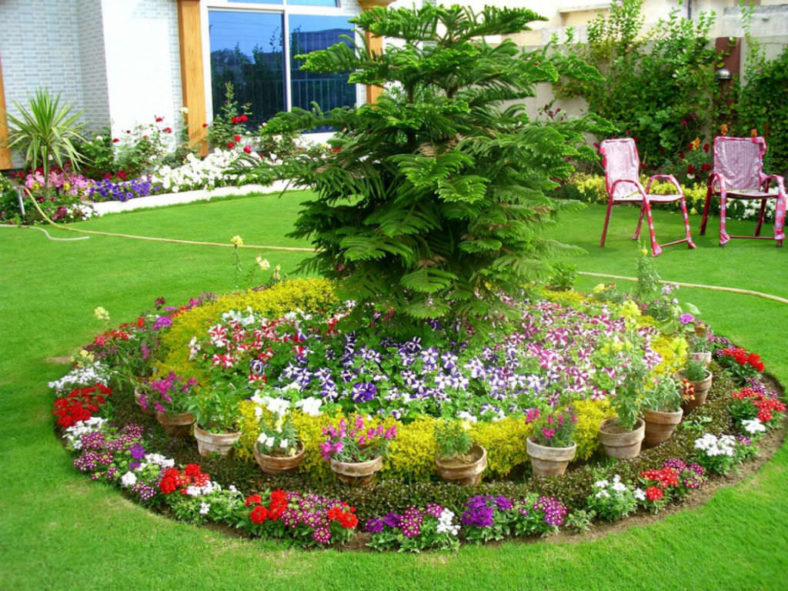Ask a child to draw a garden, and he'll draw some flowers. Give a gardener no more space than a front stoop, and what will appear there is a flowerpot. For many, flowers are the definition of a garden.
No matter your experience level, you can have blooming beauty in your life. But for your flowers to do best, it helps to understand a few basics about how flowers work and what they need.
Sun is Essential
Building a flower takes a lot of energy, and all a plant's energy comes from the sun. So most flowering plants need a full-sun site (where sunlight falls 6 to 8 hours a day throughout the growing season).
Success is in the Soil
Good soil, not too sandy and sticky, with enough organic matter to make it drain well and be inviting to plant roots, is essential for successful flower gardening, just as it is for vegetables. After all, vegetables such as squash and tomatoes are formed from flowers.

Annuals and Perennials
These are the two basic kinds of flowering plants as far as gardens are concerned. Annuals go through their whole life cycle in one growing season: sprouting from a seed, growing leaves, and roots, producing flowers, creating seeds, and then dying. They are popular with gardeners because, with reasonable care, they bloom their heads off all season. Perennials are plants whose root systems stay alive underground for several years or even decades. The part above the soil may go dormant and die back in winter, but the plant is still alive and will sprout again in spring. The trade-off for perennials' long life is that they bloom for only a few weeks or months each year. Exactly when and how long varies between species.
Which is Better?
Both have their uses in the garden. Annuals are great for places where you want many flowers, but they generally need more watering, fertilizing, and other care than perennials, and planting them every year can be a chore. On the other hand, perennials provide steady structure and form to a garden, and many gardeners delight in anticipation of waiting for their favorites' bloom time. Few are truly plant-it-and-forget-it, but they tend to need less care than annuals.
Long-term vs. Short-term
Whether you buy them as seeds or plants, perennials may take a year or more to get established and bloom in the garden, but the effort will pay off for years. If you want flowers now, annuals are the solution. But it's not an either-or thing. Many gardeners combine annuals and perennials.
This! No, that!
Annuals allow you to change the look of your garden from year to year. Even a garden with a backbone of perennial plants gets interested in different annual accents each year.
Perfect for Pots
In northern climates, annuals are best for color in containers. You can plant them in the spring, and they're done when the frost comes in the fall. That's a lot easier than trying to protect the living roots of a potted perennial through a cold winter. Some perennials may live in pots for years in climates where winter cold is not an issue. You can combine flowering annuals with perennials or foliage plants in a pot if they have compatible needs.
Seeds or Plants?
Both annuals and perennials can be sown from seed directly in the garden, but it will take a while for them to sprout, develop and bloom, several weeks for annuals, and up to a year for perennials. That's why many gardeners start seeds indoors weeks before it's warm enough to plant them outside. Or you can buy plants that have already sprouted. It's better to buy plants that aren't yet bloomed. You want them to bloom in your garden, not the greenhouse.
Labor Cost
The price of annuals' all-season bloom is that they need regular watering and fertilizing. That's because producing all those flowers all season takes a lot of water, nutrients, and sunlight. You may also need to deadhead. Pinch off dried-up blooms to encourage the plant to flower more. Perennials aren't totally carefree. Depending on the species and your climate and soil, they also need some watering and fertilizer, but not as much attention as annuals. The perennials that tend to need the least maintenance are native plants. Those that evolved in your area and thrived until gardeners came with no care at all.
In the Shade
In general, the less sunlight you have, the fewer blooms you will get. In too much shade, flowering plants may produce leaves but no flowers. Some species of annuals and perennials can bloom in less than 8 hours a day of sunlight, but you'll have to seek them out. When buying plants, carefully read labels, seed packets, or catalog descriptions.
Right Plant, Right Place
Often we fall for a flower on looks alone, regardless of whether we can give it what it needs. But you will have the most success with both annuals and perennials if you first figure out what kind of site you have (how much sun, what kind of soil, how close to the hose, how much work you are willing to put in) and then look for a plant that fits.
Source: burpee.com
Links
- Plantpedia: Browse flowering plants by Scientific Name, Common Name, Genus, Family, USDA Hardiness Zone, or Origin

